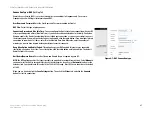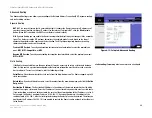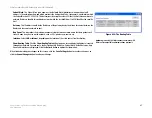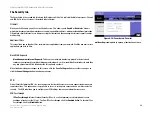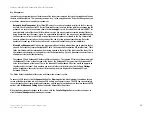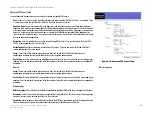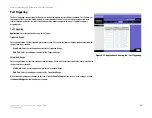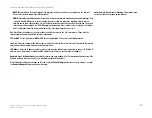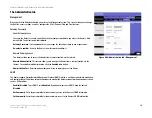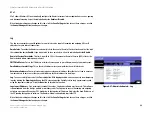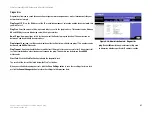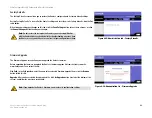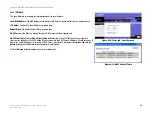
30
Chapter 6: Using The Router’s Web-based Utility
The Security tab
EtherFast Cable/DSL VPN Router with 4-Port 10/100 Switch
Any
. If you select Any for the Remote Security Group, the local VPN Router will accept a request from any IP
address. This setting should be chosen when the other endpoint is using DHCP or PPPoE on the Internet side.
Remote Security Gateway
The Remote Security Gateway is the VPN device, such as a second VPN Router, on the remote end of the VPN
tunnel. Under Remote Security Gateway, you have three options: IP Address, FQDN, and Any. In this section, you
can also set the levels and types of encryption and authentication.
IP Address
. If you select IP Address, enter the IP Address of the VPN device at the other end of the tunnel.
The remote VPN device can be another VPN Router, a VPN Server, or a computer with VPN client software
that supports IPSec. The IP Address may either be static (permanent) or dynamic (changing), depending on
the settings of the remote VPN device. Make sure that you have entered the IP Address correctly, or the
connection cannot be made. Remember, this is NOT the IP Address of the local VPN Router, but the IP
Address of the remote VPN Router or device with which you wish to communicate.
FQDN
(Fully Qualified Domain Name). If you select FQDN, enter the FQDN of the VPN device at the other end of
the tunnel. The remote VPN device can be another VPN Router, a VPN Server, or a computer with VPN client
software that supports IPSec. The FQDN is the host name and domain name for a specific computer on the
Internet, for example, vpn.myvpnserver.com.
Any
. If you select Any for the Remote Security Gateway, the VPN device at the other end of the tunnel will
accept a request from any IP address. The remote VPN device can be another VPN Router, a VPN Server, or a
computer with VPN client software that supports IPSec. If the remote user has an unknown or dynamic IP
address (such as a professional on the road or a telecommuter using DHCP or PPPoE), then Any should be
selected.
Encryption
. Using Encryption also helps make your connection more secure. There are two different types
of encryption: DES or 3DES (3DES is recommended because it is more secure). You may choose either of
these, but it must be the same type of encryption that is being used by the VPN device at the other end of the
tunnel. Or, you may choose not to encrypt by selecting Disable.
Authentication
. Authentication acts as another level of security. There are two types of authentication: MD5
and SHA (SHA is recommended because it is more secure). As with encryption, either of these may be
selected, provided that the VPN device at the other end of the tunnel is using the same type of authentication.
Or, both ends of the tunnel may choose to Disable authentication.
Figure 6-19: Key Management
Figure 6-18: Remote Security Gateway






